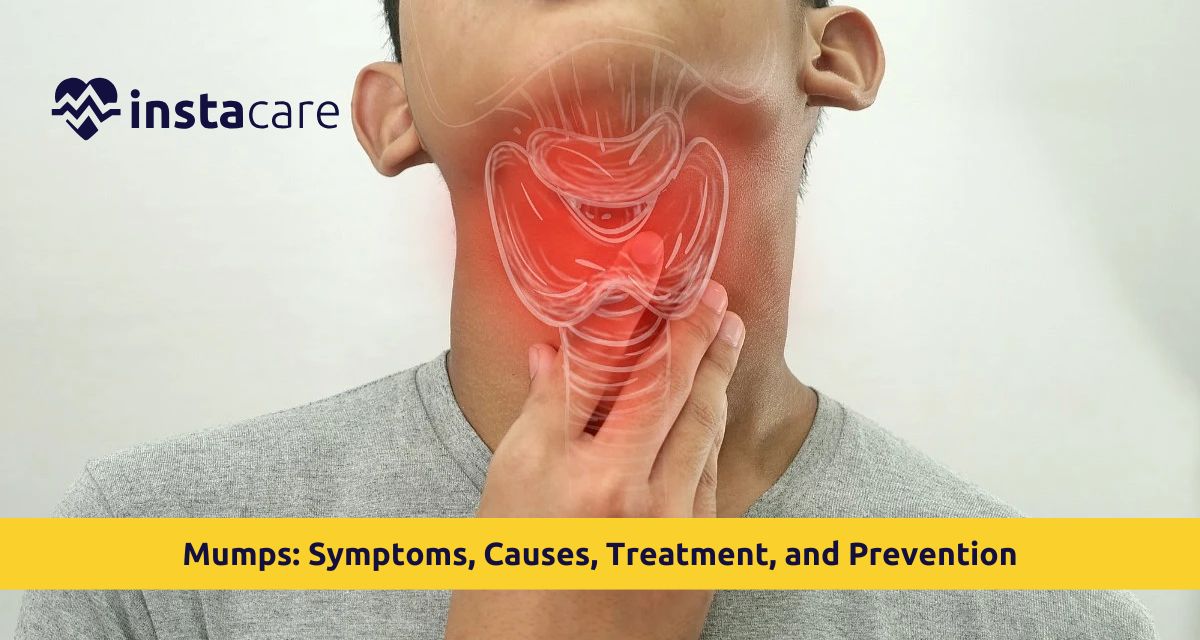Mumps is a disease which has long been thought of as being related to the salivary glands, or rather to the parotid glands found near the ears. The typical symptom of mumps is gland swelling, which will most likely lead to puffiness and rounding of the face. While the disease has been highly rare following widespread immunization, mumps in children and adults continue to exist, particularly in groups with incomplete immunization.
Although it most often recovers without a serious aftereffect, mumps can pick up serious medical conditions in certain patients, i.e., mumps orchitis of the testes in post-pubertal male patients. An understanding of the mumps symptoms, mumps causes, treatment, and mumps prevention is required to help yourself and others avoid falling prey to this contagious disease.
What is Mumps?
Mumps is caused by the mumps virus, a paramyxovirus. It is primarily diagnosed from the puffy salivary glands but also manifests elsewhere in the body, such as in the testicles, pancreas, and even the brain albeit not the usual phenomenon.
The infection is transmitted from person to person through respiratory droplets of secretions, saliva, or touching infected surface. Incubation period (interval between exposure and sickness) usually varies from 16 to 18 days but sometimes 12 to 25 days.
Even though it occurs amongst children in most cases, the disease is transmitted to adults, if not vaccinated by MMR vaccine (
measles, mumps, rubella). The virus is infectious and transmits from one individual to another at a rapid pace in schools, colleges, and families that are generally crowded.
Chief Reasons for Mumps
The only cause identified of mumps is the transmission of the mumps virus from one human to another by:
- Coughing or sneezing
- Sharing foods, beverages, or eating utensils
- Kissing or genital contact
- Contact with an infected surface and then subsequent nose or mouth contact
Once inside the body, the virus will also be duplicated in the upper respiratory system and then travel down the throat into the bloodstream. It still infects the salivary gland and causes swelling and pain associated with the disease.
The disease is most contagious several days prior to swelling and five or six days later. Trace work is challenging, and particularly in clusters. Unimmunes, due to mumps vaccine failure or waning immune status, are at greatest risk. Unvaccinated young children, teens, and young adults, particularly on college campuses or contact sports teams, are examples.
Some Symptoms of Mumps
The symptoms and signs of mumps range from mild to severe. Not all individuals will present with all the signs and symptoms of the disease, but other individuals will present with none of the signs and symptoms (asymptomatic carriers) but spread the disease.
- Enlarged salivary glands (the parotid gland most often)
- Cheek or jaw pain
- Fever
- Headache
- Muscle ache
- Nausea and weakness
- Loss of appetite
- Difficulty chewing and swallowing
The most prevalent sign of the illness is salivary gland swelling, usually on one or both cheeks. Puffiness and soreness result from swelling.
In certain people, particularly men who have undergone puberty, the virus may cause mumps orchitis, or scrotal swelling. It aches and might cause late complications like impaired fertility in certain people.
- Meningitis (inflamed membrane covering brain)
- Encephalitis (brain inflammation)
- Transitory deafness
- Pancreatitis (pancreas inflammation)
Most patients mumps recovery time within 7 to 10 days, particularly if well rested and well hydrated.
What is Included in Diagnosis of Mumps?
Mumps diagnosis begins with clinical examination through symptom of facial swelling and parotid gland tenderness. Through suspected mumps, especially in the epidemic of mumps, other laboratory examinations are used in confirmation of diagnosis.
Diagnostic tests can be:
- Saliva tests for identification of presence of mumps virus
- Blood tests for identification of presence of mumps antibodies
- Urine or cerebrospinal fluid (CSF) tests on suspected complications
- PCR (polymerase chain reaction) diagnostic tests of viral infection
Notify your physician when meeting a patient or endemic location with mumps infection. Early diagnosis not only suppresses symptoms but also suppresses infection mumps transmission.
Treatment of Mumps
No antiviral drug is to be prescribed for mumps. Majority receive symptomatic therapy for relief and prevention of complication.
Conventional mumps treatment is:
- Rest: There should be sufficient rest and reduced physical activity so that the body is recovered at a faster rate.
- Fluids: Sufficient fluids should be provided, particularly in feverish cases.
- Painkillers: Over-the-counter ibuprofen and acetaminophen can also be utilized in pain relief and control of fever in glands.
- Heat or cold packs: Applying them over swollen salivary glands areas can minimize pain.
- Soft food diet: Soft food diet can be utilized for prevention of swelling from chewing and resulting jaw pain.
- Isolation: Swelling patients with mumps should be isolated at home for a period of at least five days.
In the event of a serious mumps complication such as orchitis or meningitis, treatment and observation should be done in the hospital. Prompt action should be taken in this case.
Prevention of Mumps
Prevention is better than risk of mumps, and the vaccine is the solution. MMR vaccine is the best prevention for mumps, measles, and rubella.
- Vaccination: Two doses of MMR are needed by children, 12-15 months, and 4-6 years.
- Booster doses: A booster shot of MMR can be advised to adults at high risk during an epidemic.
- Hygiene habits: Decreasing hand washing, coughing onto the arm or a tissue, and sharing spoons/knives to eat with can all decrease contact.
- Isolation: Mumps patients do not have to be kept home from school or work, but they should avoid public facilities while still contagious.
MMR vaccine is 88% effective after the administration of the second dose. Though there will be a few cases of breakthrough disease, these are mild and less likely to have complications.
Conclusion
Mumps is a viral contagious disease, although less so nowadays as a result of mass immunization but still a cause of danger, where there is low immunization coverage. Mumps virus infects the salivary glands and results in severe pain on inflation as well as generalized malaise but can result in severe infection such as mumps orchitis and meningitis.
Fortunately, most individuals get over the disease in a week or two if treated. with adequate rest, fluids, and control of symptoms. Control and prevention of mumps are most critical. by immunization, personal hygiene, and by avoiding contact during mumps' period of infectiousness. By using the latest information and by adhering to proper routine preventive practice, you can prevent this avoidable disease in yourself and your community.
Please book an appointment with the
Best General Physician in Lahore, Karachi, Islamabad, and all major cities of Pakistan through
InstaCare, or call our helpline at 03171777509 to find a verified doctor for your disease.

